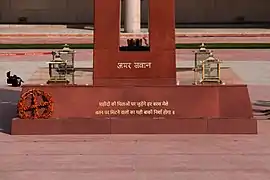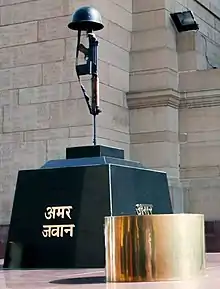Amar Jawan Jyoti
Amar Jawan Jyoti (Hindi: अमर जवान ज्योति) (English translation: Flame of the immortal soldier) is an Indian memorial constructed after the Indo-Pakistani War of 1971 to commemorate the martyred and unknown soldiers of the Indian Armed Forces who died during the war. Amar Jawan Jyoti consists of a marble pedestal on which a cenotaph is situated. "Amar Jawan" (Immortal Soldier) is scripted in gold on all four sides of the cenotaph and on top, a L1A1 Self-Loading Rifle stands on its barrel with a helmet of the Unknown Soldier on top. The pedestal is bound by four urns, one of which holds a continuously burning flame.
| Amar Jawan Jyoti | |
|---|---|
अमर जवान ज्योति | |
  Top Image: Amar Jawan Jyoti under India Gate Bottom Image: Amar Jawan Jyoti at Amar Chakra of National War Memorial | |
| For martyrs and soldiers of Indian Armed Forces. | |
| Established |
|
| Unveiled |
|
| Location | 28.612912°N 77.229510°E India Gate, New Delhi (Both Monuments) |
| Designed by | Indian Army Corps of Engineers |
अमर जवान (English: "Immortal soldier") | |
| Statistics source: Official webpage | |
The memorial is located at two places. The first one was constructed in December 1971 and inaugurated by Indira Gandhi in 1972 under India Gate at Rajpath in New Delhi and the second one was installed under the National War Memorial to honour all known martyrs (post independence) of Indian Armed Forces with their names written in 'Golden letters'. Completed in February 2019 and inaugurated by Narendra Modi on 25 February, with the igniting of the eternal flame of Jawans "Amar Jawan Jyoti".
History
The main structure (India Gate) was originally constructed in 1921 by Edwin Lutyens. Amar Jawan Jyoti was added under the India Gate in 1971.[1] From 3 December 1971 to 16 December 1971 (Fall of Dhaka), India had a military confrontation with Pakistan (Indo-Pakistani War of 1971) during the liberation war in East Pakistan.[2] Creation of Bangladesh was assisted by India during which many Indian soldiers lost their lives.[3] In December 1971, after the Indo-Pakistani War of 1971, Indira Gandhi (then Prime Minister of India) helped pay to construct the Amar Jawan Jyoti under the India Gate to commemorate the dead and unknown soldiers. On 26 January 1972 (23rd Republic Day of India), the monument was officially inaugurated by Indira Gandhi.[3][4]
Republic Day old Custom
Since 1972, every-year on the Republic Day (before the Republic Day parade), it had been customary for the President, Prime Minister, Chief of the Air Staff, Chief of the Naval Staff, Chief of the Army Staff and dignitaries to place wreath at Amar Jawan Jyoti and pay homage to the dead and unknown soldiers.[3][4][5][6]
Starting of a new Custom
From 2020 onwards, the Prime Minister of India, Narendra Modi, placed the Wreath at National War Memorial instead of India Gate on the occasion of Republic Day. Starting a new Custom taking place at new Amar Jawan Jyoti at National War Memorial accompanied by The Chief of Defence Staff , along with Army Chief, Navy Chief, and Air Force Chief who also visits the same monument on respective Service Days to pay tribute to the Fallen Heroes of the Nation, post Independence.[7]
Construction and structure
Under India Gate, in 1971
Amar Jawan Jyoti is located under India Gate at Rajpath in New Delhi. It consists of a marble pedestal on which a cenotaph is situated. "Amar Jawan" (Immortal Soldier) is scripted in gold on all four sides of the cenotaph and on top, a L1A1 Self-Loading Rifle is placed on its barrel and is capped by a helmet of the Unknown Soldier.

The pedestal is bound by four urns, in one of which a flame has been burning continuously (using CNG) since 1971.[4] The person responsible for keeping the flame burning lives in a room under the arch, next to the perpetually burning flame.[8] From 1971 to 2006, LPG was used as fuel source and from 2006, CNG is used as source. Each of the four urns has a flame but only one of the four flames burns throughout the year; on Indian Independence and Republic Days, all flames are lit simultaneously.[9] The Amar Jawan Jyoti is manned 24/7 by soldiers from the Army, Air Force and the Indian Navy.[9]
At Amar Chakra, National War Memorial, in 2019
.JPG.webp)
Amar Jawan Jyoti is also located at Amar Chakra of National War Memorial. The Memorial has four concentric circles and a central obelisk, at the bottom of which burns an 'eternal flame' representing the immortal soldier (amar jawan). The pedestal is bound by four urns, in which flame has been burning continuously, since the inauguration. The President and Prime Minister visit this memorial on National Days including but not limited to Republic Day and Independence Day. The Chief of Defence Staff , along with Army Chief, Navy Chief, and Air Force Chief also visits the monument on respective Service Days to pay tribute to the fallen Heroes of the Nation, post Independence.[7]
A global design competition was conducted and the result was announced in early April 2017. A Chennai architectural firm, WeBe Design Lab's proposal was declared the winner and was accordingly chosen for the conceptualization of the architectural design and for coordinating the construction of the project.[10] The chief architect of the National War Memorial is Yogesh Chandrahasan of WeBe Design Lab, Chennai.

Significance
Constructed after the Indo-Pakistani War of 1971, the Amar Jawan Jyoti commemorates the dead and unknown soldiers who lost their lives in the conflict, that resulted in the creation of independent Bangladesh[5] The burning flame is considered immortal.[4]

The signification became more broad when all the names of soldiers martyred in post Independence wars or other missions during their service, written in golden letters, was accompanied at the War Memorial. Amar Jawan Jyoti at Amar Chakra is now a place where nation pays tribute and commemorates their heroes reading their names at concentric Tyag Chakra.
See also
| Wikimedia Commons has media related to Amar Jawan Jyoti (Tomb of the Unknown Soldier). |
- National War Memorial (India) in New Delhi
- India Gate in New Delhi
- National Military Memorial in Bengaluru
- National War Memorial Southern Command in Pune
- National Police Memorial in New Delhi
- Kargil Vijay Diwas
- Vijay Diwas (India)
- Bijoy Dibos
References
- "The India Gate". thedivineindia.com. Retrieved 4 January 2017.
- "India-Pakistan 1971 war". The Indian Express. Retrieved 4 January 2017.
- "Amar Jyoti". discoveredindia.com. Retrieved 4 January 2017.
- "Amar Jawan Jyoti". indiagate.org.in. Retrieved 4 January 2017.
- "Significance of Amar Jawan Jyoti". indiagate.org.in. Retrieved 4 January 2017.
- "History". indiagate.org.in. Retrieved 4 January 2017.
- "Not Amar Jawan Jyoti, Republic Day wreath-laying ceremony at National War Memorial from this year". India Today. 23 January 2020. Retrieved 14 December 2020.
- "Keeper of the flame". The Indian Express. Retrieved 4 January 2017.
- "5 things about Amar Jawan Jyoti". thebetterindia.com. Retrieved 4 January 2017.
- https://thewire.in/urban/national-war-museum-delhi-india-gate